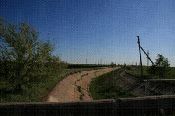|
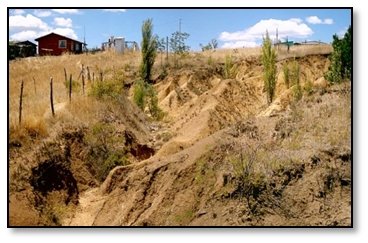 |
In the Secano interior there is a problem of soil erosion and soil degradation caused by the Mediterranean type of climate (heavy rainfall in winter) and inappropriate land management practices. Experiments were carried out on the experimental farm to decrease surface runoff and soil losses and to improve soil water availability for growing crops. |
An oat-wheat crop rotation was established and the following tillage systems were evaluated:
- no tillage (Nt);
- no tillage with subsoiling (Nt+Sb), which consisted of a subsoiler at 40 cm depth, every 40 cm perpendicular to the slope, before sowing;
- no tillage with Phalaris aquatica barrier hedges (Nt+Bh) at 12.5 m distance;
- no tillage with contour ploughing (Nt+Cp) every 12.5 m with a 1% slope to remove water from the plot; and
- conventional tillage with animal plowing (Ct) . Plot size was 1000 m².
The experiment started in 2007. For each rainfall event data on surface runoff, sediments and nutrient losses were collected using runoff storage tank. Data on rainfall and soil parameters (pH, Nitrogen, phosphorus, organic matter, bulk density, aggregate stability, soil water content, etc.) was also collected.
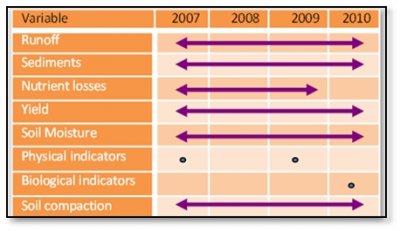 |
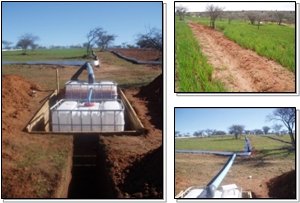 |
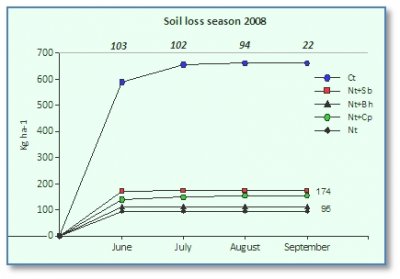 |
The results indicated that soil loss for all the treatments was less than 1 ton ha-¹. The result also shows that the runoff coefficient was more than 50% in the conventional tillage while in conservation tillage it was between 20-30%. |
 |
The study on soil compaction shows that in the second year, soil penetration resistance increased from 500 to 1500 kPa in all tillage system at a depth of 2.5-10 cm of depth. In soil depths 10-20 cm soil penetration resistance exceeded 2000 kPa in Nt, Nt+Cp, Nt+Bh, and Ct tillage systems. While in the no tillage and subsoiled treatment (Nt+Sb) it was significantly lower (1500 kPa). In the third year, soil penetration resistance in Nt+Sb remarkably increased to over 2000 kPa below 15 cm of depth, while the rest of the conservation treatments exceeded this threshold at 10 cm. The high values in soil compaction are also explained by the presence of high percentage of clay in B horizon (18 to 100 cm). They could inhibit root development. |
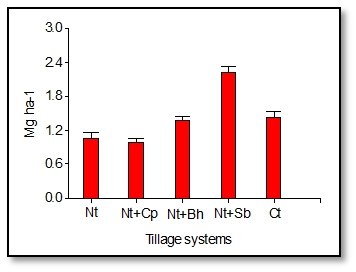 |
In the first year of the study (2007), oat grain yield and biomass production of Nt+Sb was significant (p<0.01) higher than the rest of the treatments, while Nt+Cp and Nt obtained the lowest productivity. In 2008, (more humid year) the highest wheat productivity was observed in the Nt+Sb and Ct treatments, and the lowest in Nt. Finally, in the third year oat crop production was higher in the Nt+Sb, Ct and Nt+Bh treatments compared to Nt. |
The result also showed that conservation systems preserve more soil moisture in the profile than traditional tillage (see graphs below). The crop residues left on the soil surface minimize evaporation loss and enhance infiltration.

 |
The results are evaluated from a production, socio-cultural and economic point of view. The bars express the estimated or measured percentage of change with respect to the reference situation. This change can be positive (blue) or negative (red). Note that this evaluation is based on the experiments, on the long term experience of the coordinating team in this area and on consultations with the farmers. |
A lot of farmers visited the experimental sites during 2008-2009. The stakeholders think that their quality of life will be improved because of diversified income source. The farmers have more products to sell in addition to wheat.
In 2010 a new project was established where the farmers adopted no tillage with sub-soiling and contour ploughing with barrier hedge in a wheat–oat crop rotation. |
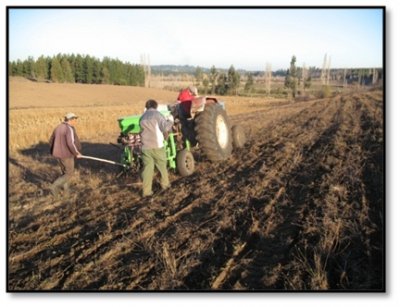 |
|
The no tillage with sub-soiling reduces soil loss by more than 70% of the soil loss as compared to conventional tillage.
|
|
Also the runoff coefficient is reduced in the no tillage and sub-soiling practices. In addition, it increases soil cover and soil organic matter.
|
|
The crop yield of no-tillage is is slightly lower than conventional syillage although with subsoiling, the yield is actually higher. No tillage saves on certain operations but there are additional farm costs for herbicides and including also additional use of farm machinery for removing the weeds and for sub-soiling will be required.
|
|

